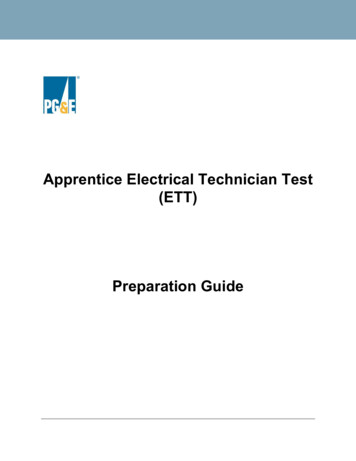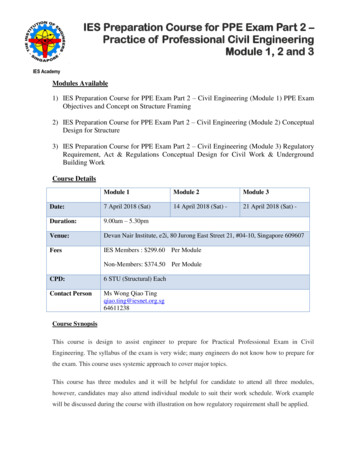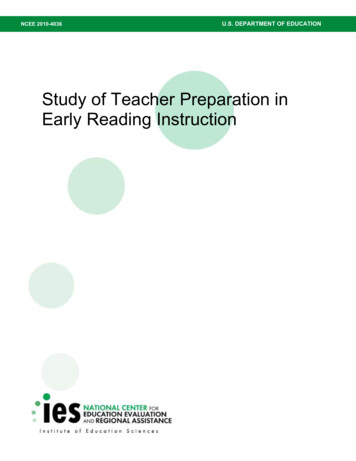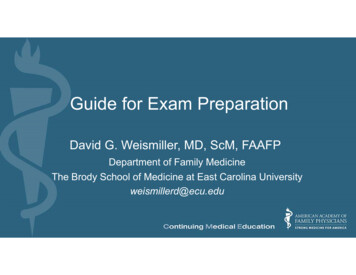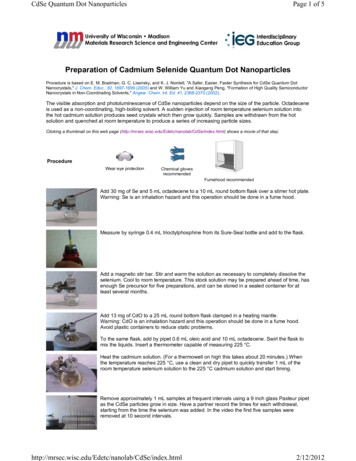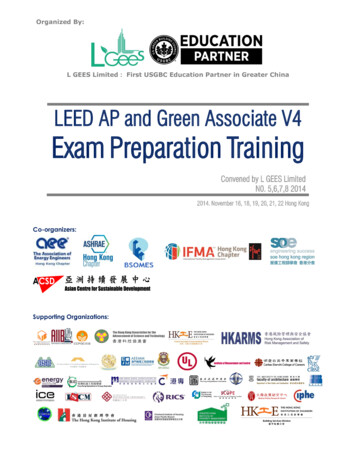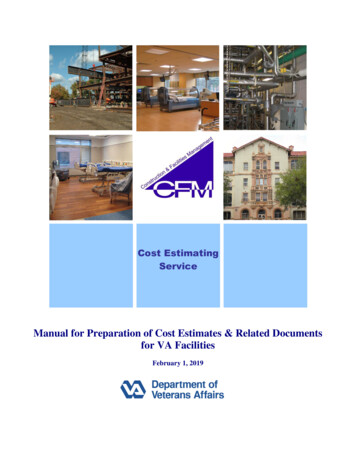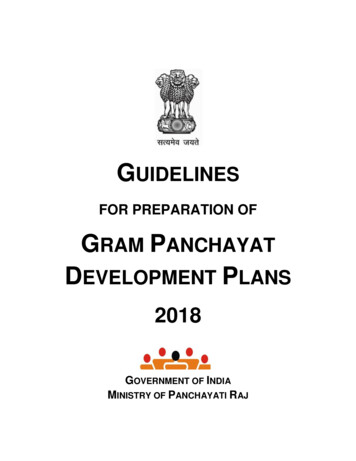
Transcription
GUIDELINESFOR PREPARATION OFGRAM PANCHAYATDEVELOPMENT PLANS2018GOVERNMENT OF INDIAMINISTRY OF PANCHAYATI RAJ
Guidelines for Preparation ofGram Panchayat Development Plan (GPDP)Table of ContentsChapterChapter 1 : Context of Gram Panchayat Development Plan1.1Background1.2Gram Panchayats and Planning for Economic Development and SocialJustice1.3Enabling Local Participatory Planning1.4Emerging Issues and Challenges1.5Need for Revised Guidelines1.6Chapter PlanChapter 2 : Importance of Planning at Gram Panchayat Level2.1Need for Comprehensive Decentralised Planning2.2Importance of GPDP2.3Special Process for GPDP in Fifth Schedule Areas2.4Panchayat-SHG Convergence for Participatory Planning at GramPanchayat LevelChapter 3 : Steps to be Taken by State Governments3.1Policy Decision on Operationalising GP Level Planning3.1.1 Decision on the Nature and Scope of GPDP3.2Setting up of an Empowered Committee at the State level3.3Framing of Detailed Guidelines for GP Level Planning3.4Creating an Enabling Environment at the State level3.5Support Systems3.5.1 Resource Envelope and Fund Flow3.5.2 Coordination Arrangements at the District and Block levels3.5.3 HR Support3.5.4 Technology and Technical Support3.5.5 Administrative and Technical Approval3.5.6 Implementation Arrangements3.5.7 Review, Monitoring and Evaluation3.5.8 Incentivizing Performance3.6Accountability Systems3.7TimelinesChapter 4 : Preparation of GPDP by Gram Panchayats4.1Formation of a Gram Panchayat Planning Facilitation Team (GPPFT)4.1.1 Tasks of GPPFT4.1.2 Formation of Working Groups in GPPFT4.1.3 Facilitator for each Gram Panchayat4.2Environment Creation4.3Cost-less or Low Cost activities4.4Focus Areas in GPDP4.4.1 Basic Services4.4.2 Economic Development and Poverty Reduction4.4.3 Human DevelopmentiPage 223242425262727282829
Chapter4.4.4 Social Development4.4.5 GPDP and SDGs4.4.6 Ecological and Environment Development4.4.7 Public Service Delivery4.4.8 Good Governance4.4.9 Skill Building4.4.10 Women and Protection & Development4.4.11 Spatial Planning4.4.12 E-enablement of Panchayat4.4.13 Infrastructure Development4.5Data Collection4.5.1 Conducting Household Survey4.5.2 Participatory Rural Appraisal4.5.3 Focus Group Discussion4.6Situation Analysis4.6.1 Objectives of Situation Analysis4.6.2 Issues to be kep in mind while undertaking situation analysis4.6.3 General examples for Situation Analysis4.7Development of Status Report (DSR)4.8Visioning Exercise4.9Prioritization of Needs4.10 Resources for Planning4.10.1 Resources Identification/Estimation4.10.2 Resource Envelope4.11 Special Gram Sabha and Inolvement of Frontline Workers of LineDepartments4.12 Preparation of Draft GPDP4.12.1 Concept of Perspective Plan (5 Years Plan)4.13 Panchayat Development Seminar4.14 Project Development/Projectisation4.15 Approval of GPDP by Gram Sabha4.16 Convergence of All Plans / Schemes through GPDP4.17 Plan Implementation4.18 Timelines for Preparation of GPDPChapter 5 : Important Schemes, Sectors and Issues for Integration in GPDP5.1Addressing needs with respect to 29 Subjects of Eleventh Schedule throughGPDP5.2Fourteenth Finance Commission (FFC) Grants5.3Convergence with Important Schemes5.3.1 Mahatma Gandhi National Rural Employment Guarantee Scheme(MGNREGS)5.3.2 Pradhan Mantri Awaas Yojana (Gramin)5.3.3 Deen Dayal Antyodaya Yojana-National Rural Livelihood Mission (DAYNRLM)5.3.4 National Social Assistance Programme (NSAP)5.3.5 Deen Dayal Upadhyaya Grameen Kaushalya Yojana (DDU-GKY)5.3.6 Schemes Related to AgricultureiiPage 940404141414242434345455455555658585960
Chapter5.3.7 The Mechanism for Marketing of Minor Forest Produce through MinimumSupport Price and Development of Value Chain5.3.8 National Mission for Green India5.3.9 Swachh Bharat Mission- Gramin (SBM-G)5.3.10 Implementation of National Food Security Act (NFSA), 20135.3.11 Áyushman Bharat5.3.12 Integrated Child Development Scheme (ICDS)5.3.13 Beti Bachao Beti Padhao (BBBP)5.3.14 Samagra Siksha Abhiyan (SSA)5.3.15 Mid Day Meal Scheme (MDMS)5.4Sustainable Development Goals (SDGs) and GPDP5.4.1 Measures for Gram Panchayat for Achieving SDGs5.5Economic Development and Income Enhancement5.6Role of Gram Panchayats in Water Conservation5.7Panchayats and Forest, Environment & Climate Change5.8Gender Responsive GPDP5.9GPDP and Children5.10 Addressing and Preventing Malnutrition5.11 Social Justice and Panchayats5.12 PRI and SHG Convergence for GPDP5.13 Disaster Management and GPDPChapter 6 : Capacity Building Framework for GPDP6.1Objectives of the Capacity Building Framework6.2Key Stakeholders6.3Institutional Support6.3.1 National Nodal Institution6.3.2 State Nodal Institutions6.3.3 Panchayat Resource Centres6.3.4 Local Level Training Institutions for GPDP6.3.5 Empanelment of National / State Resource Institutions6.4Teams of Trainers/Resource Persons for Capacity Building, Training andFacilitation of GPDP6.4.1 State Level Master Trainers’ Team6.4.2 District Resource Group (DRG) for GPDP6.4.3 Certified Resource Persons6.5Approach of CB&T for GPDP6.5.1 Combined Efforts of Training & Non-Training Interventions6.5.2 Plan of Action for CB&T for GPDP6.6Standardized Learning Material for GPDP6.7Cascading Mode of Training6.8Training Methods6.9Cross Learning of Panchayat Functionaries and Exposure Visits6.10 Convergence of the Line Departments6.11 Creating Islands of Success for GPDP6.12 Preparation of IEC Material6.13 Monitoring of GPDP CB&TChapter 7 : Integrated Decentralised Planning at Intermediate and District Level7.1Constitutional Provision for District Level PlanningiiiPage 04104
Chapter7.2Planning by Intermediate Panchayats and District Panchayats7.2.1 Planning by Intermediate Panchayat7.2.2 Planning by District Panchayat7.3Preparation by District Development Plan by DPC7.4Benefits of integrated Planning at Intermediate and District LevelChapter 8 : GPDP Implementation and Monitoring8.1Coordination Committee at District Level8.2Coordination Arrangements at Block Level8.3Community Based Monitoring8.4Social Accountability and GPDP8.4.1 Social Audit and GPDPChapter 9 : e-Panchayats and GPDP9.1GPDP in PlanPlus9.2Panchayat Enterprise Suite9.3e-Financial Management System (e-FMS)9.3.1 PlanPlus9.3.2 ActionSoft9.3.3 PRIASoft9.3.4 National Asset Director (NAD)9.3.5 Local Government Directory9.3.6 Public Financial Management System (PFMS)9.4GIS Based GPDP9.4.1 Benefits of GIS based Planning9.4.2 GIS Support in Developmental and Planning Execution of Planned ActivitiesList of TablesTable 1 – Tentative Timeline for GPDPTable 2 – Addressing 29 Subjects listed in Eleventh Schedule through Ministries,corressponding deliverables and schemesTable 3 – Ministries/Departments and Major Deliberables for GPDPTable 4 – Sustainable Development Goals (SDGs)Table 5 – Suggestive list of economic activities through PanchayatsTable 6 – Panchayat Enterprise SuitList of DiagramsDiagram 1 – Preparation and Implementation of GPDPDiagram 2 – Plan Cycle of GPDPDiagram 3 – Sector-wise data collection and compilationDiagram 4 – Resource for PlanningDiagram 5 – Architecture of Electronic Fund Management SystemList of BoxesBox 1 –Subjects listed in Eleventh ScheduleBox 2 –Role of FacilitatorsBox 3 –Making GPDP a vehcile for local development at Digambarpur GramPanchayat, West BengalBox 4 –Namma Grama Namma Yojane (GPDP) : All Inclusive Development byMalangi Gram PanchayatBox 5 –Hiware Bazar Experience in Water Budgeting and ConservationBox 6 –Beacon Panchayats in SikkimBox 7 –“Gram Samvaad” – Mobile AppivPage 6447279103112
ChapterBox 8 –DISHA PortalPage No.112AnnexureAnnexure- I :Indicative Structure and functions of Empowered Committee atthe State levelAnnexure-II:List of activities envisaged at State and District levelAnnexure-III:Functions of District and Block level Coordination CommitteesAnnexure-IV: Possible Human Resource Support for PanchayatAnnexure- V:Monitoring and Mentoring MechanismAnnexure- VI: Design of Public Information BoardAnnexure-VII: Indicative Composition of Gram Panchayat Planning FacilitationTeam (GPPFT)Annexure-VIII: Questionnaire for measuring Gram Panchayat Performance(Mission Antyodaya indicators)Annexure-IX: An Illustrative list of activities for Environment Creation at GPlevelAnnexure-X:Illustrative list of low cost or no cost activitiesAnnexure-XI: Format of Data Collection for GPDPAnnexure-XII: An indicative list of data collection sourcesAnnexure-XIII: Situation analysis based problem identification and possibledevelopment options and prioritiesAnnexure-XIV: Indicative Outline of Development Status Report (DSR)Annexure-XV: Model Schedule for Conduct of Special Gram Sabha for GPDPAnnexure-XVI: Model Structure of presentation by frontline workers/ Linedepartments during Gram SabhaAnnexure–XVII: Template for presentation of Poverty Reduction Plan for 201920 by Village OrganisationsAnnexure-XVIII: Model Chapters of GP Development PlanAnnexure-XIX: An illustrative range of activities that may feature in GramPanchayat Development Plan in addition to or in convergencewith the activities which are mandated under different SchemesAnnexure-XX: Model Format for Projectisation of Plan ActivitiesAnnexure-XXI: List of Important SchemesAnnexure- XXII: Mapping of 29 Subjects in Eleventh Schedule and MissionAntyodaya Development 138139149150152153155156159161169170172174v
Chapter 1Context of Gram Panchayat Development Plan“The greater the power of the Panchayats the better for the people.”Mahatma Gandhi1.1BackgroundIndia has remarkable achievement of continuing Panchayati Raj System, which is anintegral part of its culture and civilization. The 73rd amendment of the Constitution ofIndia provided the constitutional status and institutional framework to Panchayats tostrengthen grassroots level democracy through elected self-governing local bodies in therural areas of the country. The Constitutional amendment also emphasised functionaland fiscal decentralisation of powers to achieve good governance through people’sparticipation and thus enabling transparency, responsiveness, equity, efficiency andaccountability.1.2Gram Panchayats and Planning for Economic Development andSocial JusticeArticle 243G of the Constitution provides for:“Powers, authority and responsibilities of Panchayat.- Subject to the provisions ofthis Constitution, the Legislature of a State may, by Law, endow Panchayats with suchpowers and authority and may be necessary to enable them to function as institutions ofself government and such law may contain provisions for the devolution of powers andresponsibilities upon Panchayats, at the appropriate level, subject to such conditions asmay be specified therein, with respect to The preparation of plans for economic development and social justice; The implementation of schemes for economic development and social justice asmay be entrusted to them including those in relation to the matters listed in theEleventh Schedule.”The above provision is intended to empower the GPs by enabling the State Governmentsto devolve powers and authority including those matters listed in the Eleventh Schedulefor planning and implementation of schemes for economic development and socialjustice. This will also cover the powers to impose taxes and provisions of funds to thePanchayats.The Eleventh Schedule of the Constitution of India contains the following subjects:1
Box 1: Subjects listed in Eleventh Schedule1. Agriculture, includingagricultural extension11. Drinking Water21. Cultural activities12. Fuel and fodder22. Markets and fairs.13. Road, culverts,bridges, ferries,waterways and othermeans ofcommunication23. Health and sanitationincluding hospitals,primary health centresand dispensaries4. Animal Husbandry,Dairying and poultry15. Non-conventionalsources of energy5. Fisheries16. Poverty alleviationprogramme.26. Social welfare,including welfare ofthe handicapped andmentally retarded2. Land improvement,implementation of landreforms, landconsolidation and soilconservation.3. Minor irrigation, watermanagement andwatersheddevelopment6. Social forestry andfarm forestry7. Minor forest produce24. Family welfare14. Rural electrification,including distribution of 25. Women and ChildDevelopment.electricity17. Education includingprimary and secondaryschools8. Small scale industries,including foodprocessing industries18. Technical training andvocational education9. Khadi, village andcottage industries19. Adult and non-formaleducation10. Rural housing20. Libraries27. Welfare of the weakersections, and inparticular of schedulecaste and scheduletribes28. Public distributionsystem29. Maintenance ofcommunity assetsThus, GPs have been mandated for the preparation of Gram Panchayat DevelopmentPlan (GPDP) for economic development and social justice utilizing the resourcesavailable to them. The GPDP planning process has to be comprehensive and based onparticipatory process, which inter alia involves the full convergence with schemes of allrelated Central Ministries / Line Departments related to 29 subjects enlisted in theEleventh Schedule of the Constitution. Panchayats have a significant role to play in theeffective and efficient implementation of flagship schemes on subjects of nationalimportance for transformation of rural India. Thus, GPs are mandated to envision, planand implement GPDP to achieve economic development and social justice as shownschematically in diagram 1: -2
Diagram 1: Preparation and Implementation of GPDPPreparation andImplementationof GPDPEconomicDevelopment1.3Social JusticeEnabling Local Participatory PlanningOver the last twenty five years, several initiatives have been taken by the Government ofIndia, as well as State Governments to realize the Constitutional mandate by enabling theGPs to prepare decentralized participatory plans. The guidelines issued and modified byMoPR, GoI, from time to time on Gram Panchayat Development Plans (GPDPs), advisingthe State Governments to devise their own customized guidelines, take into account theevolving scenarios of increased allocations under MGNREGA, award of FFC vide O.M.No. 13(32) FFC/FCD/2015-16 dated 8th October, 2015 (Ministry of Finance) andguidelines vide D.O. No. J-11016/13/2015-RL dated 5th August, 2015 (Ministry of RuralDevelopment) for convergence of resources.1.4Emerging Issues and ChallengesBased on the experience of implementation of the guidelines so issued by the Union andState Governments and formulation and implementation of GPDPs over the last threeyears across the country, some new challenges as well as opportunities have emerged.This need to be taken into account for future sustainable development and social justice.Some of the important ones are as follows: Inadequate people’s participation in the planning process and Gram SabhaOver- emphasis on investments on infrastructureInadequate public service deliveryExpanding scope of Own Source RevenueIncreased role of PRIs in emerging issuesE-enablement of PanchayatsConvergence of funds, schemes and initiativesNeed to improve efficiency and efficacy in public expenditureBuilding and maintenance of physical and financial database in GPsNeed for integration of spatial and sectoral planning3
Accessing human resource and technical support for planningNeed for enhanced institutional capacities of PRIs and capacity of ERs andfunctionariesNeed for integrated plans at block and district levelsLocalizing Sustainable Development Goals (SDGs)Addressing climate change and overall environmental issuesImportance of natural resource managementEmphasis on social developmentExpanded scope for harnessing social capital in the form of PRI- SHGsconvergenceIntegrating gender, child issues, elderly and Persons with Disabilities(PwDs)Prevention of malnutritionNeed for robust monitoring and MISLikely impact of the recommendations of 15th Finance Commission and StateFinance Commission.All the concerns listed above are the challenges that need to be addressed andincorporated into the GPDP to reach out and fulfil the development aspirations of the ruralpeople through effective decentralised participatory planning by GPs. Please referChapter No. 5 for exhaustive analysis on convergence with important Schemes, Sectorsand Issues for Integration in GPDP.1.5Need for Revised GuidelinesOn the basis of critical analysis of preparation and management of GPDP, it is obviousthat present generation of GPDP needs improvement due to following reasons: Miniscule presence of major sectors like Agriculture, Woman and ChildDevelopment (WCD), Health and Nutrition, Education, Animal Husbandry, Skilldevelopment etc.Only convergence with MGNREGS (that too in few States)GPs have been formally devolved only few subjects out of 29 listed in EleventhScheduleGPs have been assigned formally few goals out of 17 SDGsGPDP being prepared as a wish listIncomplete information regarding resource envelopeLack of technical support to GPs for GPDP preparationInadequate own source of revenueNo relation between GPDP and works actually undertaken in many casesGPs are working in isolation4
No consolidation and Review of GPDP at Block/ District/ State levelsPartial uploading of GPDPs on PESTaking note of the fact that every State has developed GPDP guidelines andimplementation manuals, also trained Elected Representatives (ERs) and functionariesand the GPs in all the States have been preparing GPDPs for the last three years, it isfelt desirable by the Ministry of Panchayati Raj (MoPR), Government of India to initiateand support the States with suggestive measures to cope with the new challenges aslisted above. Further, the previous guidelines issued by MoPR were limited to theguidelines for the State Government whereas, it was found necessary to provideguidelines to GPs also. Now that all the GPs in good measure have been enabled toprepare GPDP, it is also necessary to escalate the planning process to the other two tiersof the PRI i.e., the Intermediate and the District Panchayats and further preparation ofdistrict plan by District Planning Committee (DPC). Hence there is a need for a revisedguidelines for addressing emerging challenges and opportunities in integrated planningprocess up to the district level.1.6Chapter PlanThe guidelines consist of different components for a comprehensive and integratedplanning. The document is divided into nine chapters. The first chapter discusses thecontext of local level planning, emerging challenges and need for revision in the oldguidelines for preparation of Gram Panchayat Development Plans. In the second chapter,the importance of planning at GP level has been described in brief. In the third chapternecessary steps to be taken by the State Governments are elaborated to facilitateparticipative local level Planning and effective GPDP implementation. The fourth chaptercontains the modalities and sequences of participatory planning process at the local level.Also all the formats, checklists, sources of secondary data are also incorporated in thischapter. In the following chapter incorporating important schemes, sectors and issues inGPDP have been dealt in conceptual framework. In sixth chapter, Capacity BuildingFramework for GPDP has also been included in the guidelines to give insight about theneed of structured capacity building system for better implementation of GPDP.Moreover, decentralised integrated planning at intermediate and district level have beendescribed in chapter seven. Further, arrangements for monitoring at the State, District,Block and in Community level has been incorporated in chapter eight. The final Chaptergives an overview of various e-g
Gram Panchayat Development Plan (GPDP) Table of Contents Chapter Page No. . 5.3.15 Mid Day Meal Scheme (MDMS) 70 5.4 Sustainable Development Goals (SDGs) and GPDP 73 5.4.1 Measures for Gram Panchayat for Achieving SDGs 74 5.5 Economic Development and Income Enhancement 75


